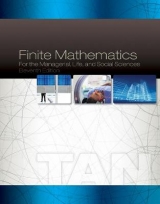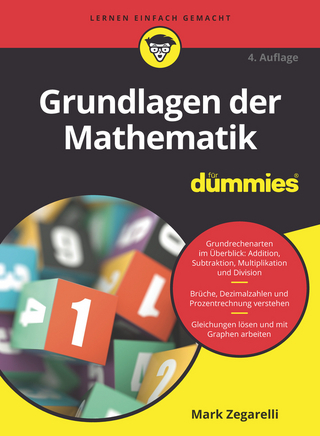
Finite Mathematics for the Managerial, Life, and Social Sciences
Brooks/Cole (Verlag)
978-0-8400-4814-1 (ISBN)
- Titel erscheint in neuer Auflage
- Artikel merken
Soo T. Tan has published numerous papers in Optimal Control Theory and Numerical Analysis. He received his S.B. degree from Massachusetts Institute of Technology, his M.S. degree from the University of Wisconsin-Madison, and his Ph.D. from the University of California at Los Angeles. One of the most important lessons I learned from my early experience teaching these courses is that many of the students come into these courses with some degree of apprehension. This awareness led to the intuitive approach I have adopted in all of my texts.""
PREFACE.
1. Straight Lines and Linear Functions.
The Cartesian Coordinate System. Straight Lines. Using Technology: Graphing a Straight Line. Linear Functions and Mathematical Models. Using Technology: Evaluating a Function. Intersection of Straight Lines. Using Technology: Finding the Point(s) of Intersection of Two Graphs. The Method of Least Squares.
Portfolio. Using Technology: Finding an Equation of a Least-Squares Line. Chapter 1 Summary of Principal Formulas and Terms. Chapter 1 Concept Review Questions. Chapter 1 Review Exercises. Chapter 1 Before Moving On.
2. SYSTEMS OF LINEAR EQUATIONS AND MATRICES.
Systems of Linear Equations: An Introduction. Systems of Linear Equations: Unique Solutions. Using Technology: Systems of Linear Equations: Unique Solutions. Systems of Linear Equations: Underdetermined and Overdetermined Systems. Using Technology: Systems of Linear Equations: Underdetermined and Overdetermined Systems. Matrices. Using Technology: Matrix Operations. Multiplication of Matrices. Using Technology: Matrix Multiplication. The Inverse of a Square Matrix. Using Technology: Finding the Inverse of a Square Matrix. Leontief Input—Output Model. Using Technology: The Leontief Input—Output Model. Chapter 2 Summary of Principal Formulas and Terms. Chapter 2 Concept Review Questions. Chapter 2 Review Exercises. Chapter 2 Before Moving On.
3. LINEAR PROGRAMMING: A GEOMETRIC APPROACH.
Graphing Systems of Linear Inequalities in Two Variables. Linear Programming Problems. Graphical Solutions of Linear Programming Problems. Sensitivity Analysis. Chapter 3 Summary of Principal Formulas and Terms. Chapter 3 Concept Review Questions. Chapter 3 Review Exercises. Chapter 3 Before Moving On.
4. LINEAR PROGRAMMING: AN ALGEBRAIC APPROACH.
The Simplex Method: Standard Maximization Problems. Portfolio. Using Technology: The Simplex Method: Solving Maximization Problems. The Simplex Method: Standard Minimization Problems. Using Technology: The Simplex Method: Solving Minimization Problems. The Simplex Method: Nonstandard Problems. Chapter 4 Summary of Principal Formulas and Terms. Chapter 4 Concept Review Questions. Chapter 4 Review Exercises. Chapter 4 Before Moving On.
5. MATHEMATICS OF FINANCE.
Compound Interest. Using Technology: Finding the Accumulated Amount of an Investment, the Effective Rate of Interest, and the Present Value of an Investment. Annuities. Using Technology: Finding the Amount of an Annuity. Amortization and Sinking Funds. Using Technology: Amortizing a Loan. Arithmetic and Geometric Progressions. Chapter 5 Summary of Principal Formulas and Terms. Chapter 5 Concept Review Questions. Chapter 5 Review Exercises. Chapter 5 Before Moving On.
5. SETS AND COUNTING.
Sets and Set Operations. The Number of Elements in a Finite Set. The Multiplication Principle. Permutations and Combinations. Portfolio. Using Technology: Evaluating n!, P (n,r) and C (n,r). Chapter 6 Summary of Principal Formulas and Terms. Chapter 6 Concept Review Questions. Chapter 6 Review Exercises. Chapter 6 Before Moving On.
7. PROBABILITY.
Experiments, Sample Spaces, and Events. Definition of Probability. Rules of Probability. Use of Counting Techniques in Probability. Conditional Probability and Independent Events. Bayes' Theorem. Chapter 7 Summary of Principal Formulas and Terms. Chapter 7 Concept Review Questions. Chapter 7 Review Exercises. Chapter 7 Before Moving On.
8. PROBABILITY DISTRIBUTIONS AND STATISTICS.
Distributions of Random Variables. Using Technology: Graphing a Histogram. Expected Value. Portfolio. Variance and Standard Deviation. Using Technology: Finding the Mean and Standard Deviation. The Binomial Distribution. The Normal Distribution. Applications of the Normal Distribution. Chapter 8 Summary of Principal Formulas and Terms. Chapter 8 Concept Review Questions. Chapter 8 Review Exercises. Chapter 8 Before Moving On.
9. MARKOV CHAINS AND THE THEORY OF GAMES.
Markov Chains. Using Technology: Finding Distribution Vectors. Regular Markov Chains. Using Technology: Finding the Long-term Distribution Vector. Absorbing Markov Chains. Game Theory and Strictly Determined Games. Portfolio. Games with Mixed Strategies. Chapter 9 Summary of Principal Formulas and Terms. Chapter 9 Concept Review Questions. Chapter 9 Review Exercises. Chapter 9 Before Moving On.
Appendix A: Introduction to Logic.
Propositions and Connectives. Truth Tables. The Conditional and the Biconditional Connectives. Laws of Logic. Arguments. Applications of Logic to Switching Networks.
Appendix B: The System of Real Numbers.
Appendix C: A Review of Logarithms.
Appendix D: Tables.
Table 1: Binomial Probabilities.
Table 2: The Standard Normal Distribution.
Answers to Odd-Numbered Exercises.
Index.
| Erscheint lt. Verlag | 1.1.2011 |
|---|---|
| Verlagsort | CA |
| Sprache | englisch |
| Maße | 215 x 279 mm |
| Gewicht | 1520 g |
| Themenwelt | Mathematik / Informatik ► Mathematik ► Allgemeines / Lexika |
| Mathematik / Informatik ► Mathematik ► Algebra | |
| Mathematik / Informatik ► Mathematik ► Angewandte Mathematik | |
| ISBN-10 | 0-8400-4814-9 / 0840048149 |
| ISBN-13 | 978-0-8400-4814-1 / 9780840048141 |
| Zustand | Neuware |
| Informationen gemäß Produktsicherheitsverordnung (GPSR) | |
| Haben Sie eine Frage zum Produkt? |
aus dem Bereich



